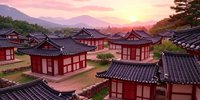Ahopsan Bamboo Forest in Busan
4 minute read

Tucked away in Gijang-gun, Busan, Ahopsan Bamboo Forest is a peaceful spot that mixes natural beauty, Korean culture, and K-drama fame. The Nampyeong Moon Clan has looked after this forest for over 400 years, keeping it safe through tough times like Japanese occupation and the Korean War. It only opened to the public in 2016, and they limit visitors each hour to keep it calm and pristine. Known for being a filming spot for dramas, its tall bamboo groves and traditional hanok draw nature fans, K-drama lovers, and folks curious about Korea’s heritage.
How to Get to Ahopsan Bamboo Forest
The forest is about a 30-minute car ride from Haeundae, or by public transport, a 45-minute bus ride from Nopo Station. When we went , the weather was clearing up after a big rain the night before, so it was nice and cool. We arrived by car to the gravel parking lot around 9:30 AM, and it was almost empty. Don’t let your GPS trick you into driving closer to the entrance, there’s no public parking up the hill. Stick to the gravel lot to save yourself some trouble.



Exploring the Forest: What to Expect
Entrance and First Impressions
After parking in the lot, we continued up the slope to the actual entry to the forest. This is marked by a fairly large rock, with a bamboo fence that is locked when the forest is closed to the public. At the time of our visit, there were bamboo souvenirs and mushrooms for sale near the front, leading to the ticket booth. Once we bought the tickets, we were each given a guide map for the forest, and we opted for maps in both English and Korean. A very gentle reminder was posted to protect the forest and each tree and blade of grass, and the rules printed in the guidebook also emphasized the importance of conservation.


Although this forest is most known for the bamboo grove, there are plenty of other flora and fauna to see as you take the 900-meter walk to the Bamboo Forest/Shamanistic Ritual Site. I was immediately captivated by the strange bird noises that surrounded us, since it has been a while since I’ve heard anything other than pigeon coos and sparrow squeaks. Our closest guess to the birds were owls and woodpeckers, although I wasn’t able to see any in person.
There are signs galore, and there were two paths available to the Bamboo Grove (대나무숲), a gentle road, and a sloping road. We opted to take the gentle road up to see more of the view. I was pleasantly surprised with the coolness of the forest, although it was a bit humid due to the rain. The tree coverage was immense, and the shade made for a pleasant walk. Sidenote: as an accident-prone person, the mats on the ground covering the dirt made for a slippery walk-up.



We walked by the Geumgang Pine Habitat (금강송군락), which is home to hundreds of pine trees, with some being older than 400 years. These trees were protected even during Japanese colonialism, and 116 of them are listed as “protected species.”
K-Drama Filming Locations
Finally, we reached the great bamboo grove. The bamboo grove is a big deal for K-drama fans, since it’s been in a bunch of shows and movies. The tall stone pillars, seen in The King: Eternal Monarch (2020), are a highlight where Lee Min-ho’s character jumps between worlds. There are signs with drama stills to point out the exact spots, great for photos or pretending you’re in the show. Other dramas and films shot here include:
- Moon Lovers: Scarlet Heart Ryeo (2016)
- 100 Days My Prince (2018)
- Memories of the Sword (2015)
- Kundo: Age of the Rampant (2014)
If you love K-dramas, you’ll get a kick out of the vibe, but there are signs telling you not to wander off the paths, especially when they’re protecting bamboo shoots.


Cultural Highlights
After exploring more of the forest, we came up to the Traditional Prayer Site, a small wooden shack that held a banner explaining how to control oneself via actions and thoughts, and curiously enough, eight 1000 won bills held down by various stones from the area. The family cemetery of the Nampyeong Moon clan can also be found around here.


We passed through more pine and oak tree habitats, before coming to an extremely tall wall made out of cut bamboo. After having Mark peek in to see what he could see, he concluded that it was just a gate that had a caravan behind it.
Finally, we made it back to the beginning, and looked at the Gwanmiheon, a hanok that was built without any nails, and just using the trees from the forest. The house is still home to those who own the mountain, and in the yard stands a 100-year-old ginkgo tree, that began sprouting in 1925. This courtyard is also home to the turtle-patterned bamboo, named for the bamboo’s uncanny resemblance to the pattern of a tortoise’s shell.


Nearby Lunch Tip
Ahopsan is a great stop if you’re exploring Gijang, and it’s easy to pair with other spots for a full day. For lunch, we went to Cheolma Yeonbap (철마연밥), a cozy place with delicious rice wrapped in lotus leaf, grilled short rib patties (떡갈비) and pork ribs (돼지갈비).


Practical Information
Operating hours:
09:00-18:00 (last entry 17:00)
Admission fees:
5000-8000 won (includes parking)

Dwaeji Gukbab Connoisseur
Most Popular Articles
Related posts

Get fit by the beach at MuscleBeach Haeundae in Busan! Enjoy workouts, tanning, and beach fun - all for free.

Join my journey through the Busan Night Walk 42K! You'll find all the information you need, and why the 16K or 22K might be perfect for you.



